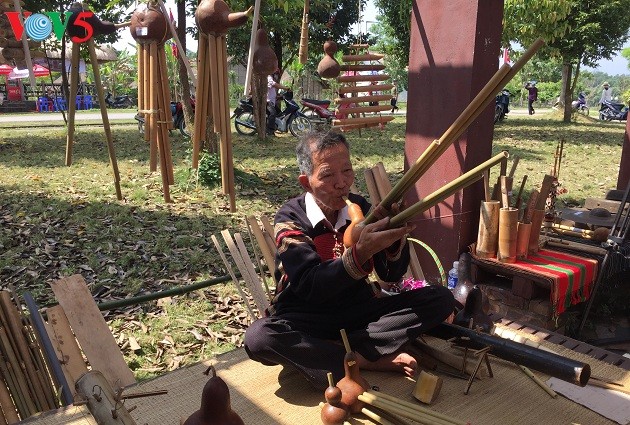(VOVWORLD) - The musical instruments of Vietnam’s ethnic minority groups are on the verge of disappearing. Most of the artisans who make them are old. But some of them are working hard to teach younger generations to make and play the instruments.
 Artisan Ama H'Loan plays E De ethnic musical instruments. Artisan Ama H'Loan plays E De ethnic musical instruments. |
Artisan Ama H’Loan of Buon Ma Thuot city, Dak Lak province, can make and play the E De people’s musical instruments. When H’Loan realized that gongs, trumpets, and flutes had disappeared from local festivals, he began to recreate them, which he learned to do when he was young. He also traveled to many places to study other E De instruments from even older artisans. His musical instruments, made from bamboo, buffalo horns, dry gourds, and beeswax, are used at local festivals and national art performances.
H’Loan said: “I had been to many places but didn’t see flutes or the percussion instruments anywhere. In 1999, when I retired, I thought of reviving those instruments because I love them. My neighbors, especially those in their 80s and 90s, were delighted when I played these instruments, which, they said, reminded them of their youth”.
 Artisan Luong Xuan Nghiep makes Thai ethnic musical instruments. Artisan Luong Xuan Nghiep makes Thai ethnic musical instruments. |
Sharing the same passion for ethnic musical instruments, artisan Luong Xuan Nghiep of Con Cuong district, Nghe An province, has set up a Thai minority folk singing club, which now has 40 members. Nghiep spends a great deal of time collecting and preserving gourd lutes (đàn tính), 2-string fiddles (đàn nhị), flutes, and wind instruments called “khèn”. He wants to transfer his love to young people.
Nghiep told VOV: “Young people love modern trendy music, no traditional music. So I set up a club, a venue where they can learn and practice folk songs and folk instruments. The result is quite encouraging. 20 of the club members are children, including my own grandchildren”.
Nghiep’s club in Cang village and a similar club in Mon Son commune often send their members to performances in Nghe An province and other localities.
Both H’Loan and Nghiep are concerned about who, in the future, will preserve and promote ethnic musical instruments when they are no longer able to do it. H’Loan told VOV: “Ethnic instruments have almost disappeared. I’m now 79. Only a few people know about these instruments. It’s very hard to find younger people who can make and play the instruments proficiently. I’ve proposed that administrators assess the situation carefully”.